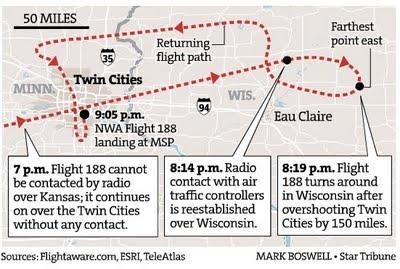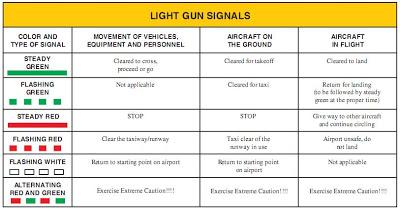NORDO is an aviation term referring to an aircraft that is unexpectedly out of radio contact...no radio. As you might imagine, NORDO has taken on new meaning since the 9/11 terrorist attacks. Not that it hasn't always been serious, but unusual or non existent radio contact was the first indication controllers working hijacked flights on 9/11 had that something wasn't right. Few have forgotten that lesson.
A high profile NORDO event occurred in 2009 when Northwest Airlines Flight 188, an Airbus A320, went without radio contact for over 75 minutes. To make matters worse, the pilots of this flight somehow managed to overfly their destination by 150 miles in spite of all the training, experience and technology available to them. In this case, it was a flight attendant calling the cockpit to find out why they hadn't started to descend who finally clued the cockpit into the fact that they had made a serious error. Both pilots not only lost their jobs, but we're eventually stripped of their pilots licenses by the United States Federal Aviation Administration.

The stakes are high in a business where errors in procedure and judgment can and do result in the loss of life. It's important to learn from our mistakes; but unfortunately, since mistakes commonly result in punishment that could include time off from work, loss of pay and even suspension of revocation of a hard earned license, self-reporting would be rare without a program known as ASAP.
Pilots, dispatchers, mechanics and even flight attendants are invited to participate in a safety reporting program known as the Aviation Safety Action Program or ASAP. The following is an excerpt from an FAA Advisory Circular published in 2002. "The objective of ASAP is to encourage air carrier and repair station employees to voluntarily report safety information that may be critical to identifying potential precursors to accidents. The Federal Aviation Administration (FAA) has determined that identifying these precursors is essential to further reducing the already low accident rate. Under an ASAP, safety issues are resolved through corrective action rather than through punishment or discipline. The ASAP provides for the collection, analysis, and retention of the safety data that is obtained."
The program provides a system for gathering useful data that will be analysed for trending safety issues in exchange for a promise that unintentional mistakes will not be prosecuted. Air Traffic Controllers have a similar self-reporting system known as ATSAP that works in much the same way.
I know all this ASAP business is a little dry, but it's important and I'll come back to it.
On a recent flight, I was at the controls while the captain worked the radios and ran checklists. We were on an Air Traffic Control vector to intercept the final approach course in visual flight conditions when the approach controller got busy handling a problem with another aircraft. The other aircraft was returning to the airport with some sort of mechanical problem and was going to land opposite direction from the normal flow of traffic.
I could see the other aircraft, a small single engine Cessna, on the TCAS screen and made a mental note of its position relative to ours. We were about the same distance from the airport as the Cessna, but we were traveling well over twice its speed and would easily beat the small plane to the airport. We were landing on different, but closely aligned runways and I didn't expect a conflict.
Normally, an approach controller will tell a pilot to call the tower on a specific frequency. Sometimes the frequency is left out of the instruction, but it's helpful information, especially at an airport with multiple tower frequencies. "Flight 123, contact tower on frequency 126.55."
As we descended through about 1,500 feet on the approach, I overheard a radio transmission that caught my attention and I realized we had not yet been switched over to the tower frequency. The captain hadn't picked up on this, so I reminded him that we were still talking to approach. Normally, if I haven't been switched over to the tower before about 2,000 feet above touchdown, I assume that the controller has forgotten to switch us over and will either transmit a gentle reminder or switch over on my own if the frequency is too congested to get a word in. In this case, there was far too much confusion and verbal congestion on the approach frequency to request the handoff, so the captain elected to switch over on his own.
By the time we first called the tower, we were descending through 1,000 feet above touchdown. This is where things got confusing and where we, as the flight crew, made a mistake.
We printed a copy of the ATIS (Automatic Terminal Information Service) about 30 minutes before landing. The ATIS informed us that the tower frequency had changed and provided a new frequency to be used. We made note of the change, but in the heat of the moment, the captain glanced down at his chart and dialed the inactive tower frequency into the #1 Comm radio. He called repeatedly, but the tower was monitoring another frequency and never heard his transmissions. In desperation, he tried the ground control and clearance delivery frequencies listed on the chart but for reasons unknown did not get an answer on those frequencies either.
By this point, we were descending through 300 feet above touchdown without a landing clearance. I considered going around, but then I remembered the Cessna. I glanced at the TCAS and noted that the Cessna was now about three miles out and still appeared to be landing opposite direction. A go-around would have put us nose to nose...most likely with no radio contact. I visually scanned the runway and the taxiways around the runway and determined that the area was clear of traffic. I told the captain that I intended to land unless he instructed me to go-around. But before he could respond I glanced at the tower and noticed the green light.
Oddly enough, I had attended the annual AirVenture fly-in aviation convention in Oshkosh, Wisconsin just weeks earlier. I walked through the FAA's exhibit while I was there and happened to pick up a sticker entitled "Air Traffic Control - Light Gun Signals." I placed the sticker, with no intention of ever needing it, inside the front cover of my Jepps binder. I remembered that the signal for "cleared to land" was a solid green light. To be honest, this was information that I hadn't reviewed in many years. The tower controller was watching. He knew we were out of radio contact. And he was using a light gun to clear us to land.

I almost missed the signal. It was dim and difficult to see and certainly would not have caught my attention if I had not looked directly at the tower, but it was the clearance we needed. As we passed through 50 feet above touchdown I started to reduce thrust, pulled slightly on the yoke and set the aircraft softly onto the runway. It's funny how clear things seem in hindsight It wasn't until after touchdown that I realized what we had done.
Ugh...that sinking feeling in the pit of your gut. No one likes to make mistakes, but I think pilots as a group are harder on themselves than most. I think its just part of being a professional...we demand the best of ourselves at all times.
I'm about to get back to that ASAP thing...
Realizing our mistake, I reminded the captain about the frequency change and he made contact with the tower. I appreciated the kind words and reassuring tone from the controller...and I got the impression we hadn't been the first to make that particular error. "No harm no foul" he said. We asked if the ground and clearance frequencies were monitored and he indicated that they were. I'm not sure why we hadn't been able to make contact on the other two frequencies.
After we completed the parking checklist, I called the tower on my cell phone and spoke to the controller who had worked our flight. The guy was understanding and affirmed our decision not to go-around. I think the idea of us going nose to nose with the Cessna while unable to communicate scared him at least as much as it scared me. He made it clear that the light gun signal was a legal clearance to land. No violation would be filed.
I feel I should add this note about the phone call. While I've done it a number of times, I have been told by people on the inside that a phone call to the tower could potentially lead to negative results. Sometimes, especially at large airports, the phone may be answered by a supervisor, not the controller who worked your flight. It is possible that the supervisor might not agree with the controller's assessment, so you could be outing yourself with the phone call. Be careful out there folks, there are ample opportunities to make your life more complicated than it needs to be.
Now back to ASAP...
The stated purpose of the ASAP program is to learn from the errors we will inevitably make, and to improve the already increasingly safe skies over the United States.
As unfortunate as it may be, the word from an air traffic controller or Federal Inspector can't always be taken at face value. It may not be intentional, but for a number of reasons, the decision to file a violation against a crew may be out of the hands of a well intentioned controller like the one I described here. I'm sure he had no intention of reporting the event, but there are internal and external reviews in place that could override that decision.
For that reason, even though I still believe we had a legal landing clearance, I elected to file an ASAP report. Unfortunately for the pilots of Northwest flight 188, the ASAP report did not save them from an inevitable outcome. Personally, I disagree with that decision, but their mistake was too great and too public to be overlooked. Mine on the other hand was quietly accepted into the program. The event has by now been "collected, analysed, and retained" and will be tracked for a possible trend.
Hopefully, I won't be the only person who learns from my mistake.
